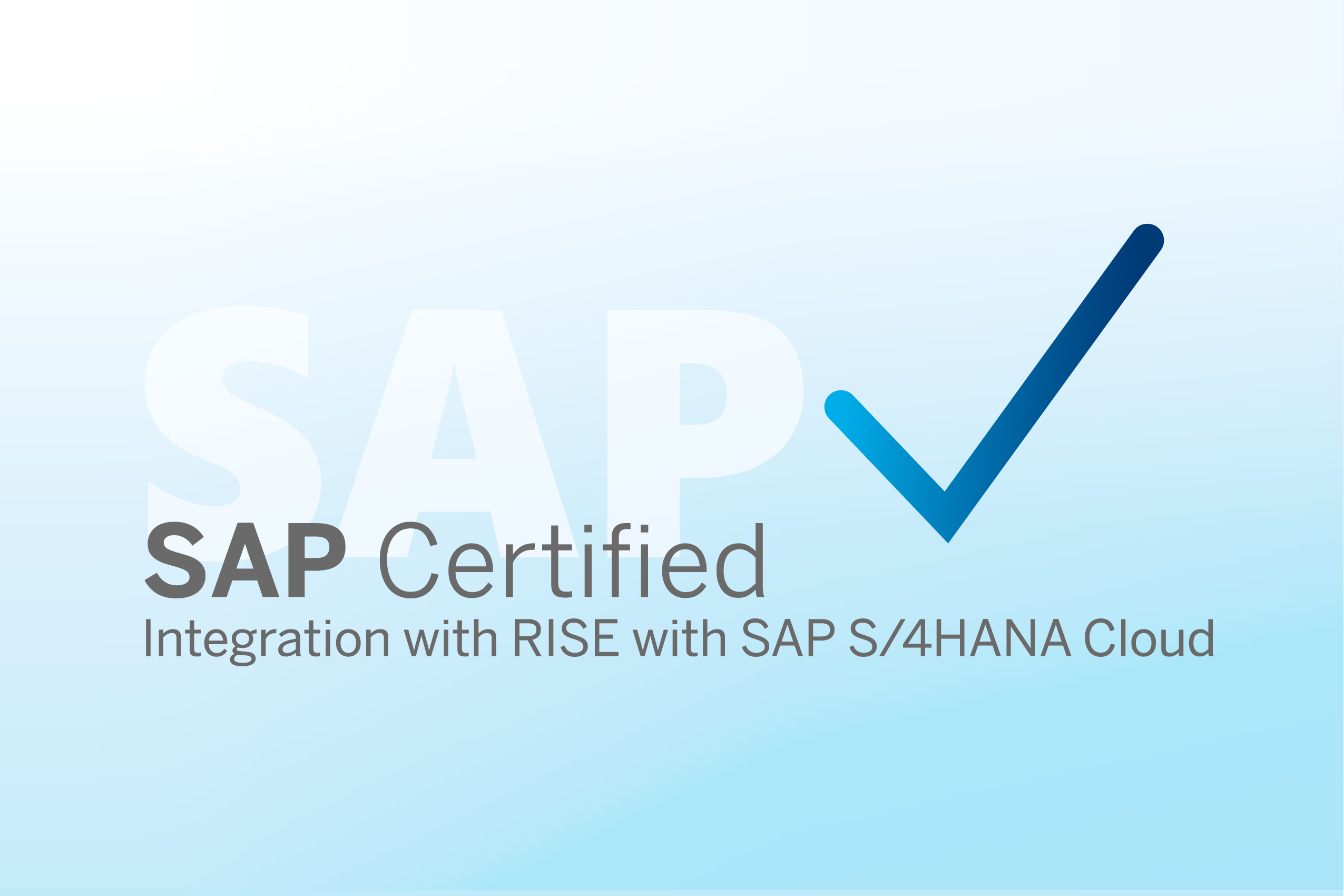Decision-makers have been encountering digital transformation as a buzzword in specialist magazines, conferences and expert panels for several years now. However, there is still room for improvement when it comes to practical implementation and application. A research project by the Centre for European Economic Research (ZEW), which deals with digitalization in SMEs, found back in 2016 that four-fifths of German SMEs did not have an end-to-end strategy for digitalizing their company.
Although digital platforms, social media and other digital technologies now dominate everyday life, many SMEs still have some catching up to do. In a survey conducted in 2021, the majority of companies surveyed in Germany stated that they saw digitalization as the biggest challenge in the next 12 months. A total of 54% of the managers surveyed saw the standardization and automation of processes as a future challenge and, in addition to efficiency increases, cost savings or more sustainable production, also expect to be able to react more flexibly to changing requests or framework conditions.
The potential, opportunities and necessity of digitalization are therefore clear. But how can SMEs get started with implementation? There are many larger and smaller solutions on the market, but which approach or which IT products are suitable for the respective company? Many decision-makers want more planning security and transparency in order to take the necessary steps and invest.
A Look Beneath the Surface of Production: A Potential Analysis with easyOEE Creates the Necessary Basis for Reliable Decisions

Transparency with figures, data and facts: Productivity is not yet systematically measured in many manufacturing companies. As a result, optimization potentials are not recognized and remain in the dark. The number of units produced often serves as an indirect indicator of productivity. If a certain number of units is achieved per shift, for example, production was satisfactory, if not, less so. However, producing according to gut feeling is not an exact method, because gut feeling is at best suitable for comparison. But: only what you can measure and what you are aware of can be permanently improved. It’s worth taking a closer look!
Example Key Figures: With the help of OEE, a company’s productivity can be increased without high costs. Recording and reporting OEE can make a significant contribution to increasing margins. More output in the same amount of time with the same operating costs and less unrest and stress in production due to fewer disruptions are motivating factors for addressing the topic of OEE.
Procedure: The potential analysis with our productivity measuring device easyOEE serves as a preliminary project for the implementation of the MES FASTEC 4 PRO. easyOEE is a quick and easy to install self-sufficient complete system for recording the productivity of individual machines, lines, systems and assembly work centers and reporting it online from the PC workstation: We support our customers with commissioning, data validation and the implementation of initial optimizations. The easyOEE productivity measuring device is connected to a machine. Your electrician can process existing digital signals or install a light barrier. The configuration is based on your master data. The machine operator registers a production order on the device at the start of production. easyOEE then automatically records quantities and production times.
As soon as there is a downtime, the machine operator selects the reason for the fault from a preconfigured list and can refine it using user texts. It is also possible to process technical faults on the machine automatically. The quality of the products can be differentiated by connecting an NOK counter or entering the rejects manually. The web browser gives you access to the device and transparency in production. If a network connection is not feasible, offline operation is also possible. The recorded data is displayed in live views and can be conveniently reported.
Transparency Without Risk: the Analysis is Designed for a Period of Three Months

FASTEC coordinates the project planning and objectives with you. The device is delivered and a configuration file is sent. You connect the device to the machine while FASTEC prepares the configuration. We support you with a kick-off as well as with our support and online help at any time. Commissioning and training takes place on your premises. After approx. two weeks, the recorded data is validated together and any necessary adjustments are made. The verified machine data is analyzed together after a further 2-4 weeks and optimizations are derived. In order to measure the success of the optimizations, a final evaluation takes place at the end of the project. As a result, our customers have exact figures on optimization potential, cost savings and can derive possible investments in optimization measures.
Best Practice: Up to 30% Increase in Output at NaBento Vliesstoff GmbH in Ellefeld (Huesker Group)
NaBento Vliesstoff GmbH is part of HUESKER Synthetic GmbH, which develops and produces intelligent geo-technology. Within the HUESKER Group, each production site is allowed to decide for itself which software is used in production. The plant in Ellefeld employs just 30 people on two lines, making it a relatively small production site. It produces geomembranes that can safely and economically replace conventional mineral-based seals. A potential analysis was carried out in production using easyOEE and opportunities to increase output were successfully identified.
Initial Situation at NaBento
The ERP system from SAP is used in production. For a long time, production data was still recorded manually, meaning that shift reports and quantities produced were recorded manually in paper-based shift logs. In addition, only estimates were made for set-up and cleaning times, which resulted in a very inaccurate database. In addition, there was a high administrative burden and confusing mountains of paper in production, resulting in a lack of objectivity and transparency in the recording and reporting of production data. A change of personnel in production management triggered the search for a digital solution. Potentials in production were to be identified in order to initiate optimizations and increase efficiency in production. The first step was to collect, structure and analyze data.
Christopher Fischer, Plant Manager at NaBento Vliesstoff GmbH, explains:
The optimal solution for us was to first explore the potential of production and test digital data acquisition on a system without making any major investments. In addition, communication with FASTEC was very good right from the start: simple and clear.
The Step Into Digital Production
The benefits of easyOEE were quickly apparent in day-to-day operations: the digital solution has eliminated a lot of paperwork and manual work. The potential analysis revealed the weak points in production using one system as an example and provided real-time transparency about the current status of production. “Thanks to easyOEE, we have identified the potential to increase output by 20-30%, which was previously unrecognizable. We are delighted to be able to realize this potential on all systems with FASTEC 4 PRO,” confirms Christopher Fischer.
Several systems are now being gradually bound to FASTEC 4 PRO. The focus here is on the scalability of the software solution. Christopher Fischer justifies this decision with the positive results of the potential analysis and the good cooperation with FASTEC. In addition, this decision lays the foundation for further digitalization measures. An MES is particularly strong in the collection of operating and machine data and thus provides the foundation on the path to digital transformation.
Goals of Digitalization at NaBento
- Increased efficiency: Optimization of processes on all systems to further increase output
- Transparency: current status display on screens in production and on mobile devices
- Visualization: Support for machine operators, production managers, technical managers and management with intuitively understandable data
Christopher Fischer, Plant Manager NaBento Vliesstoff GmbH, summarizes the results:
Thanks to the potential analysis with easyOEE, we knew that investing in an integrated solution would be worthwhile and more economical in the long term.
Seize Opportunities
Based on these successes, NaBento initiated the project start with the holistic software solution FASTEC 4 PRO. The implementation of MES software is also worthwhile for the small, medium-sized site due to its flexible scalability, so that extensions are to follow after completion of the first project with FASTEC 4 PRO. The software is also to be taken into account in the current ideas for site development and the acquisition of a new plant. Furthermore, an SAP interface is planned to digitally integrate production orders into the MES and to write quantities and times back to the ERP system.
Conclusion
SMEs are often more flexible and agile than large corporations, as they have to go through fewer coordination processes. This is also a decisive advantage on the path to digital transformation. On the other hand, the hurdles seem large and unpredictable due to financial expenses, for example. In order to cushion these uncertainties, the potential analysis procedure with easyOEE offers small and medium-sized companies in particular the opportunity to put investment decisions on a solid footing. The data obtained with easyOEE is the right basis for justifying decisions to invest in digitalization measures and convincing sceptics. Initial optimization potentials can be implemented directly and it can be precisely quantified whether an investment is worthwhile. Measures such as the introduction of MES software can then be planned in concrete terms – without financial or time-related risks!
With modular modules, the MES software solution can then be implemented step by step and in line with requirements. Machine Data Acquisition (MDA) and Production Data Acquisition (PDA) as an introduction can be gradually supplemented with additional modules such as Detailed Scheduling, Quality Assurance, Maintenance or Traceability as well as extensive Additional Functions to analyze and optimize processes. This allows scrap quantities to be increased and costs to be reduced proportionately. In the long term, the entire operating process becomes more effective and flexible and remains competitive in the long term. This approach puts the path to digital production on a solid footing, making it significantly easier and faster.








